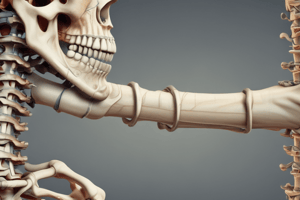Podcast
Questions and Answers
What is the primary function of the spinal column?
What is the primary function of the spinal column?
- To provide protection to the heart
- To produce blood cells
- To support the body and enable posture and movement (correct)
- To facilitate respiratory movements
How many cervical vertebrae are present in the spinal column?
How many cervical vertebrae are present in the spinal column?
- 7 (correct)
- 10
- 12
- 5
Which vertebrae are responsible for supporting the majority of the upper body's weight?
Which vertebrae are responsible for supporting the majority of the upper body's weight?
- Lumbar Vertebrae (correct)
- Cervical Vertebrae
- Thoracic Vertebrae
- Sacrum Vertebrae
What is the main function of intervertebral discs?
What is the main function of intervertebral discs?
What structures guide and limit the movement of the spinal segment?
What structures guide and limit the movement of the spinal segment?
What does the spinal canal house?
What does the spinal canal house?
What is the role of the spinal cord?
What is the role of the spinal cord?
What is the structural composition of the nucleus in intervertebral discs?
What is the structural composition of the nucleus in intervertebral discs?
Which vertebrae are fused to form the sacrum?
Which vertebrae are fused to form the sacrum?
Which of the following is NOT a characteristic of thoracic vertebrae?
Which of the following is NOT a characteristic of thoracic vertebrae?
Flashcards are hidden until you start studying
Study Notes
Spinal Column Overview
- The spinal column, or backbone, is essential for providing support to the body, enabling upright posture, bending, and twisting.
- Comprises 33 individual vertebrae that interlock to form a structured column.
Vertebrae Classification
-
Cervical Vertebrae (C1 - C7):
- Located in the neck.
- Supports the head and allows for nodding and shaking movements.
-
Thoracic Vertebrae (T1 - T12):
- Consists of 12 vertebrae.
- Joined by ribs to form the rib cage.
-
Lumbar Vertebrae (L1 - L5):
- Comprises five sturdy vertebrae.
- Supports most of the upper body's weight, providing a stable center of gravity during movement.
-
Sacrum and Coccyx:
- Sacrum consists of five fused vertebrae.
- Coccyx, or tailbone, is made up of four fused vertebrae.
- Together, they form the back wall of the pelvis.
Intervertebral Discs
- Located between each movable vertebra.
- Structure: thick outer layer (annulus) encasing a soft, gel-like center (nucleus).
- Function as shock absorbers, facilitating movement and protecting vertebrae.
Spinal Motion Segment
- Each intervertebral disc works with two facet joints to form a spinal motion segment.
- Facet joints guide and limit the movement of the spinal segment.
- Cartilage on joint surfaces allows smooth movement.
Spinal Canal
- Formed by the vertebral bodies creating a vertical tunnel.
- Houses the spinal cord and spinal nerves, providing protection from injury.
Spinal Cord and Nerve Roots
- Major column of nerve tissue connecting the brain to the body.
- Functions as an information superhighway for transmitting signals.
- Nerves branch off from the spinal cord to form pairs of nerve roots that travel through openings known as intervertebral foramens.
Spinal Column Overview
- The spinal column, or backbone, is crucial for body support and facilitates upright posture, bending, and twisting.
- Comprises 33 vertebrae interconnected to create a stable structure.
Vertebrae Classification
- Cervical Vertebrae (C1 - C7): Located in the neck, supports the head, and allows nodding and shaking motions.
- Thoracic Vertebrae (T1 - T12): Consists of 12 vertebrae; connects with ribs to form the rib cage, providing stability and protection.
- Lumbar Vertebrae (L1 - L5): Five robust vertebrae that bear most of the upper body's weight, contributing to a stable center of gravity during movement.
- Sacrum and Coccyx:
- Sacrum consists of five fused vertebrae and forms the posterior wall of the pelvis.
- Coccyx, or tailbone, consists of four fused vertebrae, aiding in pelvic stability.
Intervertebral Discs
- Located between each movable vertebra, acting as a cushion.
- Structure includes a thick outer layer (annulus) surrounding a soft, gel-like center (nucleus).
- Functions as shock absorbers, supporting movement and protecting adjacent vertebrae from wear and tear.
Spinal Motion Segment
- Each spinal motion segment comprises an intervertebral disc and two facet joints, allowing for controlled movement.
- Facet joints guide and restrict spinal segment motions; cartilage on joint surfaces ensures smooth movement.
Spinal Canal
- Formed by aligning vertebral bodies, creating a vertical tunnel.
- Houses and protects the spinal cord and spinal nerves, mitigating injury risk.
Spinal Cord and Nerve Roots
- The spinal cord represents a major nerve tissue column linking the brain to the body.
- Functions as an information superhighway for signal transmission between the brain and peripheral body parts.
- Nerve roots branch from the spinal cord, exiting through intervertebral foramens to connect with the body.
Studying That Suits You
Use AI to generate personalized quizzes and flashcards to suit your learning preferences.




